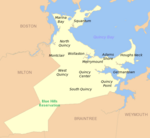House at 32 Bayview Avenue
Houses completed in 1880Houses in Quincy, MassachusettsHouses on the National Register of Historic Places in Norfolk County, MassachusettsNational Register of Historic Places in Quincy, MassachusettsNorfolk County, Massachusetts Registered Historic Place stubs ... and 1 more
Queen Anne architecture in Massachusetts

The House at 32 Bayview Avenue in Quincy, Massachusetts, is a modest Queen Anne style house built on the shore during Quincy's development of that area as a summer resort area. It was built in the 1880s, sited to take advantage of the views of the Town River to the north. It features relatively modest stylistic details, including varying gable sizes with bargeboard, and a wraparound porch with square posts and some Stick style woodwork.The house was listed on the National Register of Historic Places in 1989.
Excerpt from the Wikipedia article House at 32 Bayview Avenue (License: CC BY-SA 3.0, Authors, Images).House at 32 Bayview Avenue
Bay View Avenue, Quincy
Geographical coordinates (GPS) Address Nearby Places Show on map
Geographical coordinates (GPS)
| Latitude | Longitude |
|---|---|
| N 42.271388888889 ° | E -70.955138888889 ° |
Address
Bay View Avenue 32
02191 Quincy
Massachusetts, United States
Open on Google Maps









